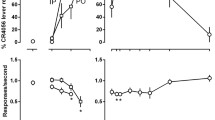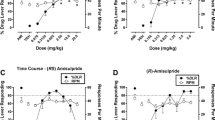Abstract
Long Evans rats were trained to discriminate 0.2 mg/kg IP (±)-rolipram from vehicle injection in a food-motivated two-lever operant task. Eight out of nine rats acquired the discrimination after an average of 91 sessions (min 65, max 137). The ED50 of (±)-rolipram was 0.06 mg/kg IP. Generalization tests with (−)- and (+)-rolipram showed that the (−)-isomer was 8 times more active than (+)-rolipram with an ED50 of 0.06 and 0.4 mg/kg IP respectively. The phosphodiesterase inhibitor RO 20-1724 partially (83%) generalized to (±)-rolipram in doses of 0.6 and 1.0 mg/kg IP. IBMX 5 mg/kg IP showed 63% generalization. Tests with imipramine and the (+)- and (−)-isomer of the noradrenaline uptake inhibitor oxaprotiline suggest that NA-uptake inhibiting drugs do not form an interoceptive cue which is (±)-rolipram-like. dbcAMP 12.5 mg/kg SC and 100 mg/kg SC dbcGMP did not generalize to the training drug. The nature of the discriminative stimulus produced by this dose of (±)-rolipram in rats remains to be elucidated.
Similar content being viewed by others
References
Colpaert FC, Slangen JL (1982) Drug discrimination: Applications in CNS pharmacology. Elsevier Biomedical Press
Colpaert FC, Niemegeers CJE, Janssen PAJ (1980) Factors regulating drug cue sensitivity: limits of discriminability and the role of a progressively decreasing training dose in fentanyl-saline discrimination. J Pharmacol Exp Ther 212:474–480
Davis CW (1984) Assessment of selective inhibition of rat cerebral cortical calcium-independent and calcium-dependent phosphodiesterases in crude extracts using deoxycyclic AMP and potassium ions. Biochim Biophys Acta 797:354–362
Delini-Stula A, Hauser K, Baumann P, Olpe HR, Waldmeier P, Storni A (1982) Stereospecificity of behavioural and biochemical responses to oxaprotiline — a new antidepressant. Adv Biochem Psychopharmacol 31:265–275
Elsner J (1982) PASTOR: A new schedule programming language. Behav Res Methods Instrumentation 14:254–263
Horowski R, Sastre-Y-Hernandez M (1985) Clinical effects of the neurotropic selective cAMP phosphodiesterase inhibitor rolipram in depressed patients: Global evaluation of the preliminary reports. Curr Ther Res 38:23–29
Przegalinski E, Bigajska K (1983) Antidepressant properties of some phosphodiesterase inhibitors. Pol J Pharmacol Pharm 35:233–240
Schneider HH (1984) Brain cAMP response to phosphodiesterase inhibitors in rats killed by microwave irradiation or decapitation. Biochem Pharmacol 33:1690–1693
Schwabe U, Miyake M, Ohga Y, Daly JW (1976) 4-(3-cyclopentyloxy-4-methoxyphenyl)-2-pyrrolidone (ZK 62711): a potent inhibitor of adenosine cyclic 3′,5′-monophosphate phosphodiesterases in homogenates and tissue slices from rat brain. Mol Pharmacol 12:900–912
Wachtel H (1982) Characteristic behavioral alterations in rats induced by rolipram and other selective adenosine cyclic 3′,5′-monophosphate phosphodiesterase inhibitors. Psychopharmacology 77:309–316
Wachtel H (1983a) Potential antidepressant activity of rolipram and other selective cyclic adenosine 3′,5′-monophosphate phosphodiesterase inhibitors. Neuropharmacology 22:267–272
Wachtel H (1983 b) Neurotropic effects of the optical isomers of the selective adenosine cyclic 3′,5′-monophosphate phosphodiesterase inhibitor rolipram in rats in vivo. J Pharm Pharmacol 35:440–444
Author information
Authors and Affiliations
Additional information
Offprint requests to: R. Ortman
Rights and permissions
About this article
Cite this article
Ortmann, R., Meisburger, J.G. Rolipram forms a potent discriminative stimulus in drug discrimination experiments in rats. Psychopharmacology 89, 273–277 (1986). https://doi.org/10.1007/BF00174358
Received:
Revised:
Issue Date:
DOI: https://doi.org/10.1007/BF00174358




